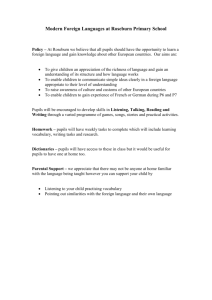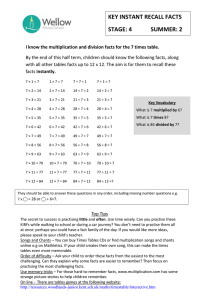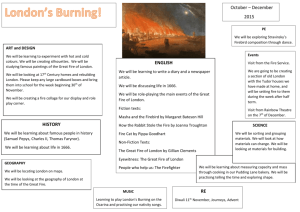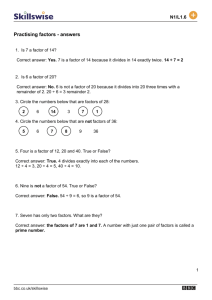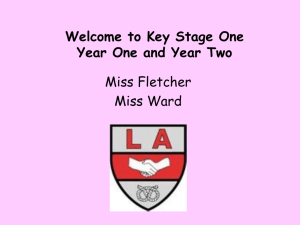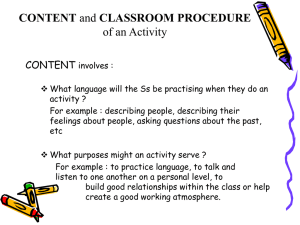Wainscott Primary School Handwriting Policy June 2016
advertisement
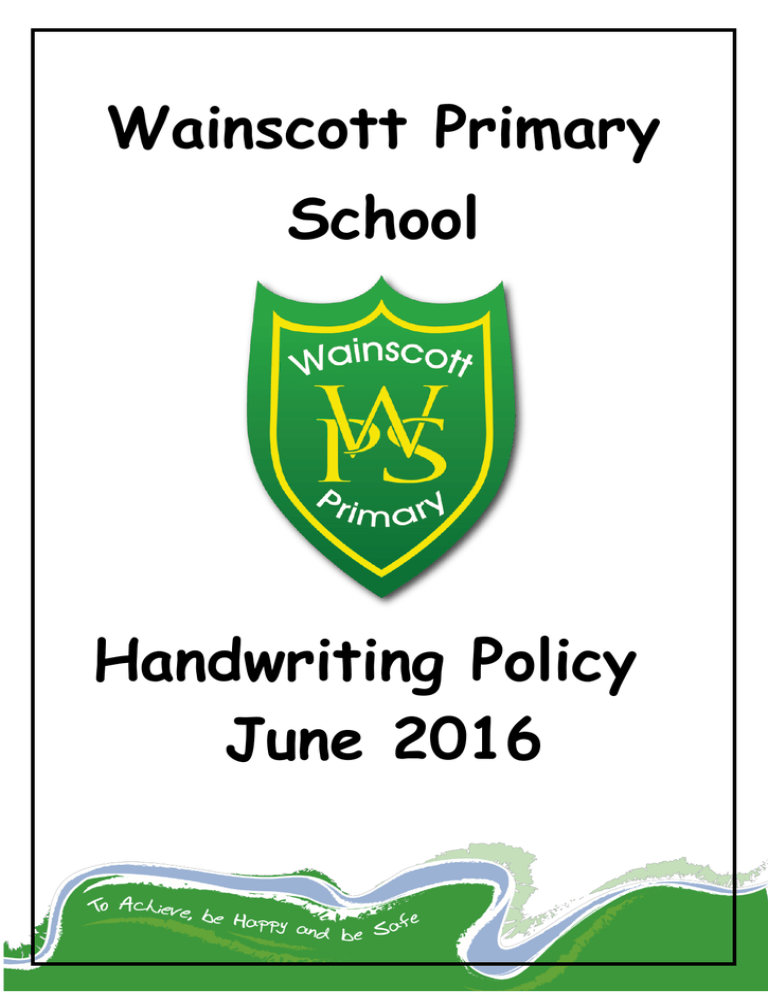
Wainscott Primary School Handwriting Policy June 2016 Handwriting Policy and Guidelines Aims For Teachers 1. To know the correct style, letter formations and joins in handwriting to ensure consistency across the school 2. To understand the progression in handwriting so that pupils are taught in every lesson and pupils’handwriting develops and improves 3. To ensure high expectations in handwriting lessons and that pupils are expected to apply the same standards in other independent writing For Pupils 1. To know the importance of clear and neat presentation in order to communicate meaning effectively 2. To write legibly in both joined and printed styles with increasing fluency and speed by; • Having a correct pencil grip • Knowing that all letters start from the top, except d and e which start in the middle • Forming all letters correctly • Knowing the size and orientation of letters Teaching time EYFS little and often but closely supervised. Years 1 and 2 at least 3 weekly sessions lasting no more than 10 minutes. Years 3 and 4- three 15 minute sessions a week. Years 5 and 6- two to three 15 minute sessions a week. As well as time to practise. For example, presenting work for display. 1 Model used Wainscott Primary School uses the Nelson Handwriting Scheme with the following letter formation: Lower case letters Capitals A B C D E F G H I J K L M N O P Q R S T U V W X Y Z Cursive Script The Four Joins 1. to letters without ascenders 2. to letters with ascenders 3. horizontal joins 4. horizontal joins to letters with ascenders The break letters (letters that aren’t joined from) are: bgjpqxyzs (See appendix 2 for examples of the break letters) Resources Teachers can use the Nelson Scheme Teacher Resource books and the Interactive Whiteboard Resources ‘which can be located via the website. Nelson font is also stored on a disc which teachers can download on to their classroom laptops. 2 Books Most pupils will use their Literacy books for handwriting so that they are learning to write on lines that are the same size as the books they will produce most of their work in. Some pupils may use the small blue books with red lines if they are still learning to form individual letters correctly or write in a reasonable size. (See the Literacy Leader for advice if necessary). Work for presentation and display will be written on plain paper using line guides. Pencils and Pens Pupils will use HB pencils initially and move onto Berol blue ink pens. Children at Key Stage 1 use sharp pencils with grips if they require them. At year three children are able to gain their ‘Pen Power’ award if their writing is neat and consistent and are able to write in pen in all their books with the exception of Numeracy. Pens must be introduced in hand-writing lessons in Year Four at the latest. When pupils start to use pens in their independent writing they may supply their own pen which must be a blue ink pen. Some pupils will find their writing is neater in pencil and should be given the choice to use pen or pencil in independent writing. However, all pupils should be taught to use them in handwriting lessons. Getting ready to write Seating and posture Chair and table should be at a comfortable height The table should support the forearm so that it rests lightly on the surface and is parallel to the floor Encourage children to sit up straight and not slouch The height of the chair should be such that the thighs are horizontal and feet flat on the floor Tables should be free of clutter 3 Rooms should be well lit Left handed pupils should sit on the left of their partners Pencil grip A tripod grip is the most efficient way of holding a pencil For right handers Hold lightly between the thumb and forefinger about 3cm away from the point The paper should be placed to the right tilted slightly to the left Use the left hand to steady the paper For left handers Hold lightly between thumb and forefinger resting on the first knuckle of the middle finger Hold about 3cm from the tip The hand should be kept below the writing line although some pupils will find a ‘hook’ more comfortable The paper should be tilted slightly to the right at about 20 30° Use the right hand to steady the paper NB It is very important that a right handed child is NOT seated on the left hand side of a left handed child as their elbows will collide! 4 Assessment Children must be assessed on entry into Year Three to see if they are using the correct letter formation for individual letters first. If they are not starting in the correct place they will not be able to join letters accurately. Pupils who need to learn correct letter formation for some letters must be taught this before they begin to join. Some pupils will have begun to learn and use joined handwriting in Year 2 and will need to start from that position in the Progression Ladder (See Appendix 1 for Progression Ladder). Teachers will assess pupils at the start of the year and decide where teaching should begin in the Progression Ladder. The year group starting points are a guide and teachers will need to use their professional judgement. However, be aware of the expectations at the end of the year. Pupils should be grouped into 2 or 3 ability groups based on their handwriting ability (this may be different to their writing level). Work will be differentiated and a teaching assistant may teach and work with one ability group. The SLT in team meetings should monitor children’s writing and presentation in books regularly (as part of the monitoring cycle). The following should be considered: • Is the writing generally legible? • Are the letters correctly shaped and proportioned? • Are the joins made correctly? • Are the spaces between the letters, words and lines appropriate? • Is the size of the writing appropriate? • Is the writing properly aligned? • Are the writing standards achieved by the majority of pupils in line with the National Curriculum? 5 Individual assessment Children should be observed as they write during handwriting lessons – the teacher must circulate, monitor and intervene. Teachers also need to monitor and mark whole pieces of writing. The following should be considered: • Is the posture correct? • Does the child hold the pencil correctly? • Does the child use the correct movement when forming and or joining letters? • Are any letters reversed or inverted? • Does the child write fluently and rhythmically? • Is the writing easily legible? • Is the pupil’s handwriting development in line with the the National Curriculum? Teacher Modelling It is essential that teachers model neat and cursive writing in shared writing on the whiteboard, interactive whiteboard and in pupils’ books. Teachers’ writing must be consistent with the Nelson model. Application Pupils should be encouraged to apply the hand-writing they are taught in all independent writing. Teachers must have high expectations of all pupils and expect to see examples of what they have been taught in all books. If pupils are learning joined hand-writing they should be expected to use this in their written work. Pupils should only attempt joins if they have been taught them. Teachers must monitor this and use praise and next steps marking to bring this to pupils’ attention where appropriate. 6 Incentives Rewards, incentives and praise will be used to encourage good practice. These include Good Workers in assembly, team points, written work for the display boards and the annual hand-writing competitions. Pupils respond to positive praise. If we make our expectations clear and are consistent ourselves then the pupils will be. 7 APPENDIX 1 Progression ladder Order of teaching Single letters (YR and Y1) •cadgqo •esf •ilt •uyjk •rnm •hbp •vwxz Joins Y2 (going into Y3) Introduction of the four hand-writing joins: • First join; un um ig id ed eg an or ing ung • Second join; ch sh th tl ll ill sli slu ckackststi ink unk • Third join; odpg re veoonoom • Fourth join; wlvl of ffflflo • Practise the break letters b p g q y j z • Practise capital letters 8 Joins Y3 (going into Y4) Revision • Practise the break letters b p g q y j z • Practise capital letters Further practise of the four hand-writing joins • inine • utute • ve vi • ok oh • sh as es (practising two ways of joining the letter s) • rirury (practising joining from the letter r) • oa ad as (practising joining to and from the letter a) • eeeaed (practising joining from the letter) • owov ox (practising joining from the letter o) • kyhyly (practising joining to the letter y) • ha ta fa (practising joining to the letter a) • odooog( practising joining from the letter o) • erirur (practising joining to the letter r) • ai al ay • o you oi • reoefe (practising the horizontal join to the letter e) • fuwu vu (practising the horizontal join to the letter u) • otol ok (practising joining to ascenders) • ai al owol (practising all the joins) 9 Year 4 • ning ping ting • oc od oo • akeome are • flaflofle • whowhawhe • ie in il • inlykyny • apar an • ickuckack • practise writing with a slope • he • we • re • fte fir fin • wrawrikni (silent letters) • iillttrrnn mm cc ooddssffee • ewev ex (spacing) • thhtfl (proportions) • acagaf • Capital letters • Decorated capital letters • Practising with punctuation ! ? – “ “ , ‘ 10 Years 5 and 6 • Practise and ensure consistency and size of letters • Practising using a diagonal joining line • Practising leaving an equal space between letters • Practising joining to the letter y • Practising using a horizontal joining line • Practising the size and height of letters • Practising joining from the letter i • Practising joining to and from the letter v • Practising consistency in forming and joining letters • Practise speedwriting • Practising crossing double tt on completing the woek • Practising joining to and from the letter e • Practising joining to and from the letter w • Practising printing • Practising drafting and editing • Practising joining to the letter t • Practising with punctuation • Practising break letters • Practising joining from the letter m • Ensuring the ascender on the letter t is the correct height • Practising spacing within words • Developing fluency • Practising printing • Practising forming and joining the letter f • • Practising speed writing • Revision • Looking at different handwriting styles 11 APPENDIX 2 Examples of the break letters 12 APPENDIX 3 Examples of the joins Rose Callaway June 2016 13
